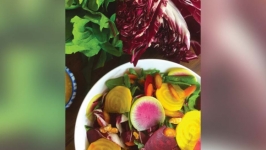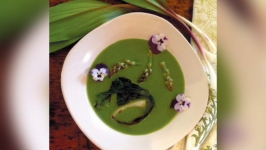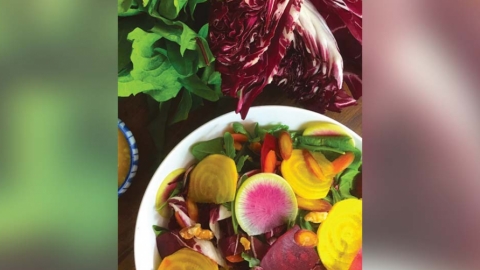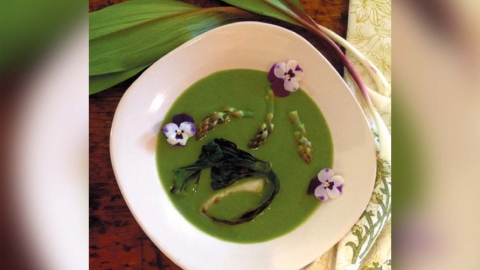Don’t Let the Name Stop You, Bitter Greens have a Lot to Offer
The word “bitter” doesn’t have the best connotation, especially when associated with food. Bitter greens may sound unappealing at first, but when you delve into the array of offerings coupled with the health benefits of consuming these more unusual leafy greens, you just may want to give them a try.
As a very basic definition, bitter greens are green, leafy vegetables that taste, well, bitter. Their bitter bite comes from a chemical compound known as glucosinolates. But coupled with that slightly unusual taste is a boatload of health benefits. Bitter greens are heavy with nutrients and often referred to as nutrient-dense super foods. Most include vitamins A, C and K as well as potassium, calcium and magnesium. They’re also low in sodium and high in fiber. Plus, bitter greens are a powerful source of antioxidants that are thought to prevent chronic disease and cognitive decline.
So which greens fall into the bitter category? The most familiar is kale. And although kale seems to get all the glory these days, it’s not the only bitter green in town. There are plenty of other greens out there that pack a powerful punch. Often overlooked in the produce aisle are greens like watercress, arugula, escarole, Belgian endive, radicchio, mustard greens and yes, even dandelion greens.
Before you turn up your nose to the bitter side of greens, let me tempt you by offering more information along with some mouthwatering recipes to try. I think you will soon agree that with the proper preparation, a little bit of bitter is a positive, not a negative when it comes to these nutrient-rich leafy greens.
THE SUPERPOWERS OF WATERCRESS
Let’s start with a bitter green you may be familiar with: watercress. It may look dainty with its delicate frilly leaves, but that bunch of watercress holds quite a culinary and nutritional punch. The Center for Disease Control and Prevention has deemed watercress the world’s most nutrient-rich vegetable. Gram for gram, watercress contains over 50 vital vitamins and minerals and contains more calcium than milk, more folate than bananas and more vitamin C than oranges. These tender greens have a unique spicy flavor that adds a bit of zip to any dish, raw or cooked.
My favorite way to enjoy watercress is giving it a couple of culinary partners to make a scrumptious spring soup. My asparagus watercress soup is a creamy concoction that retains its bright green color by initially blanching the asparagus and watercress in simmering water. After 30 seconds, plunge in cold ice water. The bright green colors of both will be locked in. Although the soup is delicious served unadorned, if you’re feeling fancy, drizzle with some Greek yogurt (thinned with a bit of milk) and top with a few reserved blanched asparagus spears. If you are lucky enough to have a couple of wild ramps in your back yard, clean them up and blanch or grill them for an elegant touch on the finished soup.
THE COLORFUL WORLD OF CHICORIES
You’ve probably run into a chicory or two at the market but wondered what to do with them. Chicories are descended from a European and Asian flowering plant with a long taproot. There are two main cultivated species: endive that includes feathery-looking lettuce heads like frisée and escarole and chicories that include Belgian endive and radicchio. Chicories are a wonderful addition to a dish that can offset or even highlight their unique flavor profile. Plus, with hues ranging from bright red and deep purple to apple green and off-white, chicories add a pop of color to any dish.
The hearty chicory leaf can take a bit of heat. Try throwing some endive or radicchio on the grill. Cut the heads in half and brush liberally with extra virgin olive oil, then let the heat of the grill slightly char those leaf tips. Plate and garnish with your favorite cheese (I favor a delicate Montrachet to offset the bitter leaves) and drizzle with balsamic vinegar and extra-virgin olive oil.
In the raw form, I favor a salad made with the colors and flavors of spring. Radicchio leaves and Belgian endive are combined with colorful spring produce like shaved golden and red beets, multi-colored carrots and festive radishes. If you can find one, a watermelon radish, with its bright pink center and light green border, makes a dazzling edible topper for the salad. Drizzle with a simple lemon Dijon mustard vinaigrette for a healthy dose of spring.
DON’T FORGET DANDELION GREENS AND ARUGULA
With their pointed delicate leaves, dandelion greens and arugula seem fairly unassuming. But one bite in and you’ll discover a mouthful of bitter mixed with just the right amount of spice.
Most of us think of dandelions as a pesky weed that pops up in our spring lawn. Dandelion greens, however, are full of vitamins A, C and K as well as a multitude of minerals and loads of fiber. The toothy-looking leaves of those small invasive flowers are completely edible. One note of caution: Avoid picking dandelion greens from your garden unless you have specifically planted them for harvest. I buy mine at an organic market, all cleaned and ready to go.
Arugula, also known as garden rocket, is an edible plant in the brassica family along with cruciferous vegetables like broccoli, cauliflower, cabbage and collard greens. Originally from the Mediterranean, the peppery leafy green has long been a staple in Italian and French cuisine. Arugula has become popular in the United States over the past few decades and is now commonly used as salad greens.
I pair the two greens in a homemade pesto made with olive oil and unsalted pepitas. The spicy flavor of the arugula offsets the slight bitterness of the dandelion greens. Mix a generous dollop of the pesto with your favorite cooked pasta or transform it into a spring appetizer with fresh burrata cheese, heirloom tomatoes and lightly toasted French bread.











